10 Easy Ways To Change Your Writing Tone (With Examples)
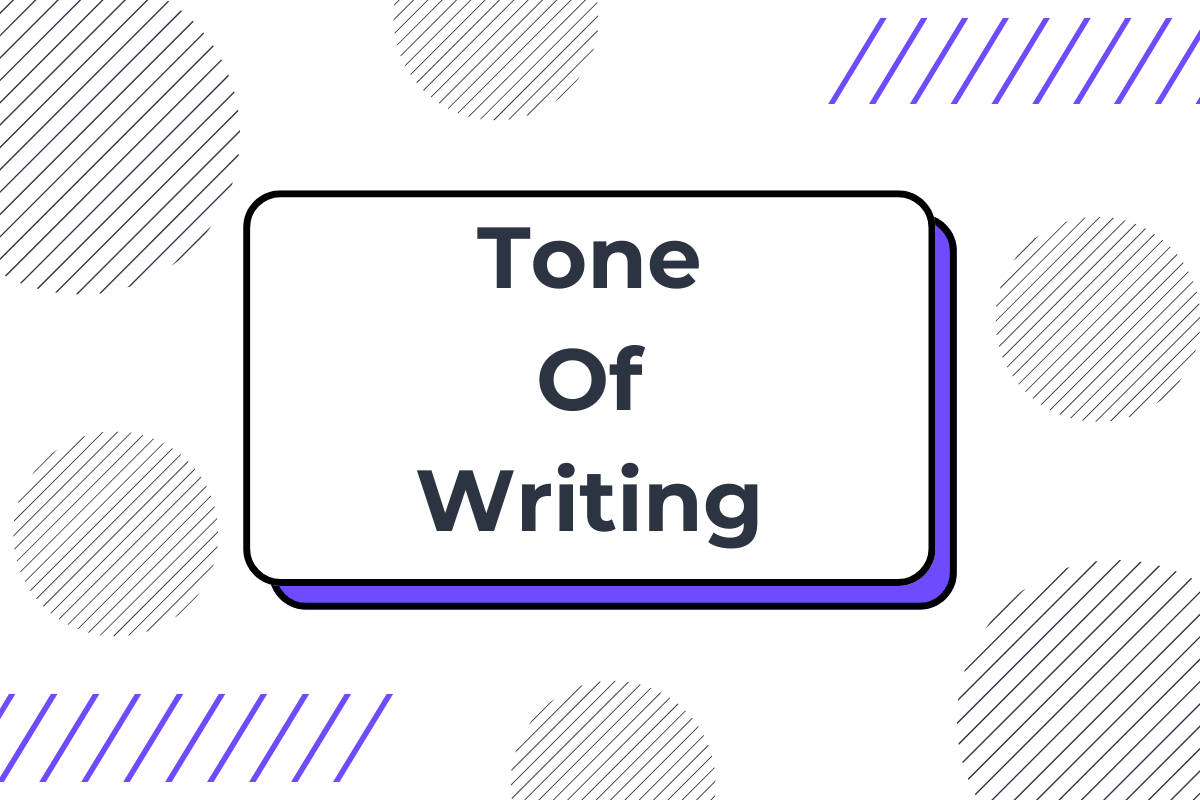
You stare at your screen, frustrated.
Your content sounds flat or just... off.
Whether you're writing emails that need to sound friendlier or blog posts that should be more professional, changing your writing tone can feel challenging at times.
But here's the thing: adjusting your tone doesn’t have to be that hard.
With the right techniques, you can easily edit your piece and match the brand tone.
This guide will show you 10 effective ways to transform your writing tone. You'll discover exactly how to shift from formal to casual, professional to friendly, or technical to conversational (without spending hours rewriting).
Ready? Let’s get into it!
Understanding Writing Tone At A Glance
Your writing tone comes from three key elements:
-
Word choice
-
Sentence structure
-
Writing pace.
Think of emails you receive—some feel warm and friendly, while others sound cold and distant. The difference? It's all in these three components.
The wrong tone can turn readers away in seconds.
Readers stop reading when the tone doesn't match their expectations.
For example, a casual "Hey there!" in a formal business proposal feels off. Similarly, stiff formal language in a personal blog post creates distance between you and your readers.
Your content needs different tones for different situations:
-
Professional: Clear, direct, and respectful
-
Conversational: Friendly and natural
-
Technical: Precise and detailed
-
Persuasive: Confident and compelling
-
Empathetic: Understanding and supportive
Before You Start: Analyze Your Current Writing Tone
The 3-Minute Tone Check
Take a piece of your writing and mark every adjective and adverb. Circle all instances of passive voice. Highlight transition words. This quick analysis reveals your natural writing patterns.
Identifying Tone Patterns
Read your last three pieces of content. Notice patterns in your:
-
Sentence length (short, long, or mixed)
-
Word choices (formal vs. casual)
-
Paragraph structure (dense or spacious)
-
Punctuation style (minimal or varied)
Using AI to Speed Up Tone Analysis
Modern AI tools can analyze your writing tone in seconds. They identify elements like formality level, emotional tone, and readability.
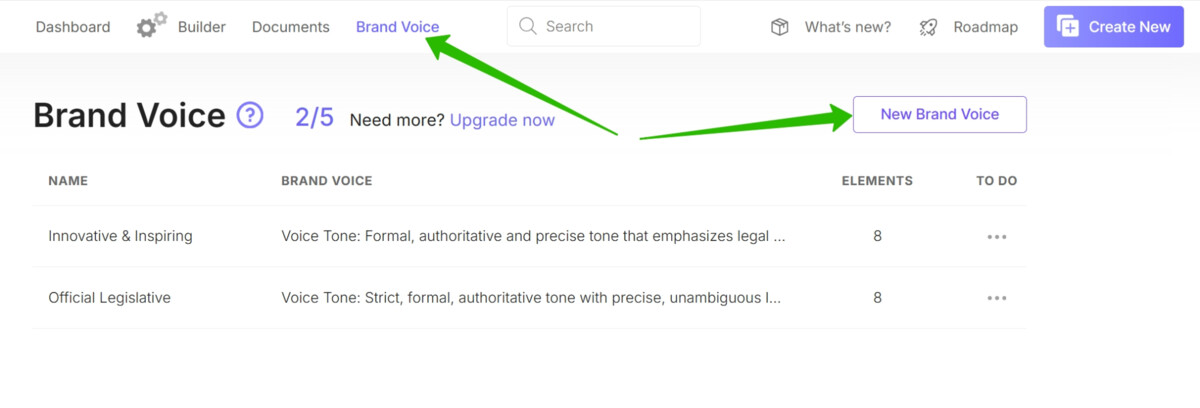
SEOWriting's Brand Voice Customizer, for instance, helps you write SEO-optimized content based on exact writing style and brand tone.
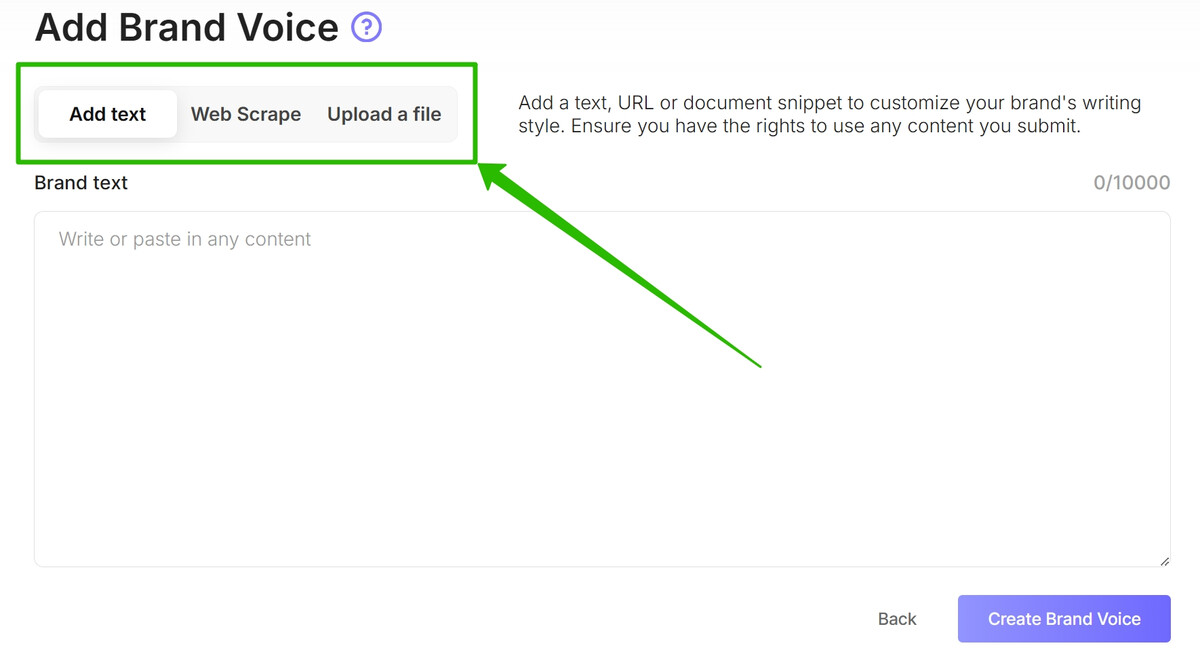
1. Just upload or paste your writing.
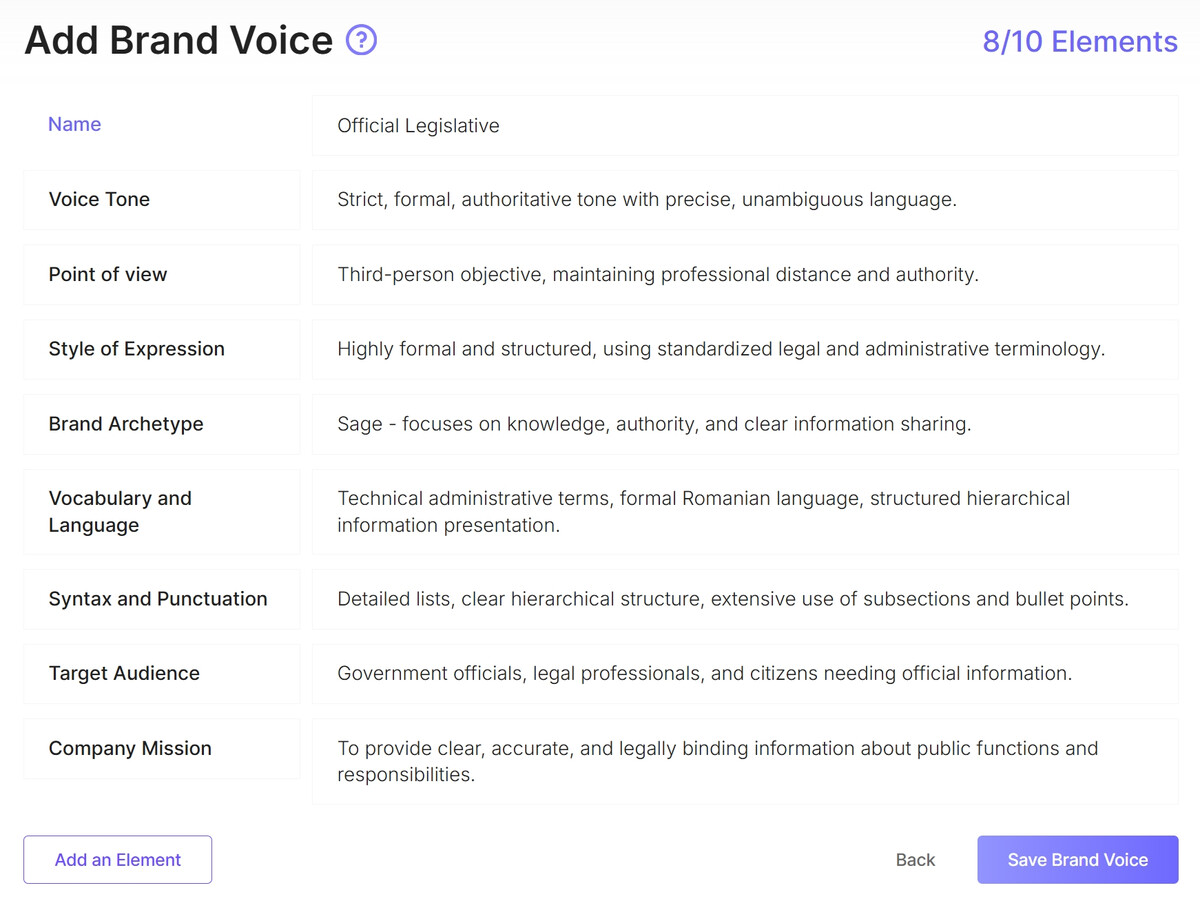
2. SEOWriting will analyze and give a complete overview of your brand voice, tone, and writing style.
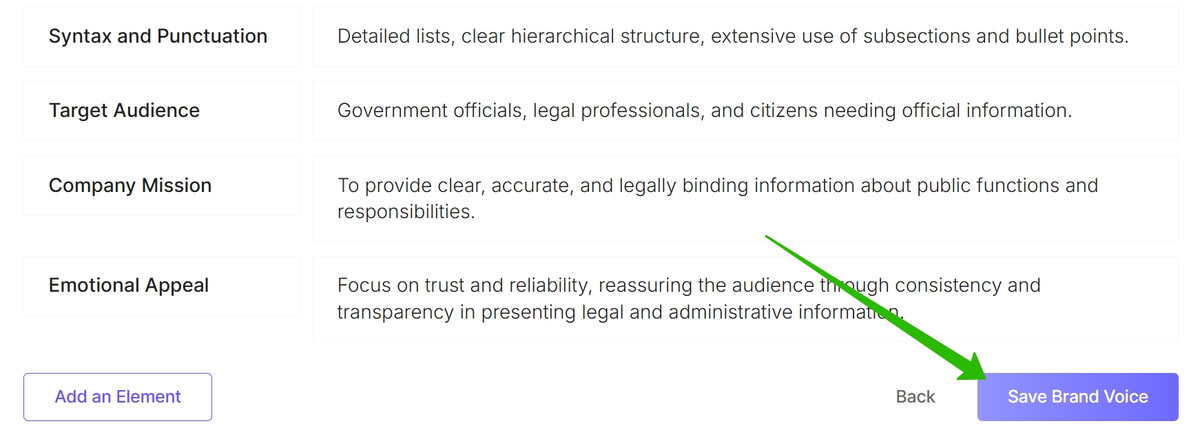
3. You can save it and use it, every time you generate a blog post with it. Learn more about SEOWriting.
Now let’s see how you can change the tone of your writing with some effective techniques.
10 Effective Ways To Change The Tone Of Writing
1. Adjust Your Sentence Structure
Your sentence structure shapes how readers experience your content. A mix of different sentence types helps you control the emotional impact of your writing and makes it more engaging to read.
Short sentences are impactful. They grab attention. They create emphasis. But use too many, and your writing feels choppy.
Long sentences allow you to explain complex ideas and create a smooth, flowing rhythm that pulls readers along with your thoughts—but they require more focus to follow and can lose impact if used too often.
The secret? Use both strategically. Start with a short sentence. Follow it with a longer one that develops your idea. Then hit readers with another short one for emphasis.
This will help you turn your tone of writing from sounding flat, and choppy, to more interesting and engaging.
Here's are some examples:
1. Finance:
Original (Stuffy tone): "Effective budget management requires meticulous tracking of expenditures and strategic allocation of financial resources."
Revised (Relatable tone): "Take control of your money in 10 minutes a day. Track what you spend, set clear goals, and put aside small amounts each week. Your savings will grow faster than you expect."
2. Gardening:
Original (Complex tone): "Optimal plant cultivation requires consideration of soil composition, solar exposure parameters, and moisture regulation."
Revised (Simple tone): "Your plants need three things to grow: good soil, the right amount of sun, and proper watering. Check these basics daily and your plants will grow better than ever."
2. Choose Power Words Strategically
Words carry emotional weight. The right word choice can transform your message from forgettable to unforgettable.
So, replace bland words with powerful alternatives:
-
"Good" becomes "exceptional"
-
"Bad" becomes "devastating"
-
"Happy" becomes "thrilled"
-
"Sad" becomes "heartbroken"
But remember: power words work best when used sparingly. Too many strong words can make your writing feel overdramatic.
Another important thing to remember:
Match your vocabulary to your audience's expertise level. A tech blog might use "implement" and "optimize," while a cooking blog uses "blend" and "simmer."
Here's an example:
Technical: "Implement advanced optimization protocols to enhance system efficiency."
General Audience: "Make your system run faster with these simple tweaks."
3. Modify Your Punctuation Patterns
Punctuation does more than follow grammar rules. It controls the pace, emphasis, and emotional impact of your writing.
Look at these examples:
Formal: "Furthermore, the quarterly results indicate positive growth across all sectors."
Casual: "Guess what? Our numbers are up... way up! Every single department crushed their goals (yes, even accounting)."
You can also use question marks to engage readers directly. They make your writing feel more like a conversation.
Exclamation points are also worth considering as they add excitement to your writing! But too many make you sound over-eager!!! (See how annoying that gets?)
Limit yourself to one exclamation point per paragraph. You can also avoid using it in professional writing settings.
Another effective punctuation you can use: Colons and Semicolons. They connect related ideas; they create a sophisticated tone. But short sentences feel more direct. More effective. More modern. So, choose based on your target tone.
4. Shift Perspectives According To Writing Themes
Your choice of perspective changes how readers connect with your content. Each point of view serves a specific purpose.
First person is good to create a personal and relatable tone. It works great for stories and building trust. "I've tested this method myself" feels more authentic than "This method has been tested."
But watch out—too much "I" and "we" can make your writing feel self-centered. Use first person for:
-
Personal experiences
-
Behind-the-scenes insights
-
Direct recommendations
Now the second person: "You" directly addresses your reader. It makes them the hero of the story. It works especially well for:
-
How-to guides
-
Product descriptions
-
Advice articles
Here's how perspective shifts change tone:
Third Person: "The customer should consider their options carefully."
Second Person: "You'll want to weigh your options carefully."
First Person: "I always tell my clients to weigh their options carefully."
Pro Tip: Mixing Perspectives Effectively. The most engaging content often mixes perspectives strategically. Start with "you" to hook readers, use "we" to build connection, and sprinkle in "I" for credibility. Just keep the shifts smooth and purposeful.
5. Use Dialog And Direct Address
Adding conversation elements to your writing creates instant connection with readers. It transforms your content from a lecture into a discussion.
For example, Questions pull readers into your content.
"Have you ever struggled to make your writing sound more professional?" This technique creates an immediate bond—readers mentally answer "yes" and become more invested in your solution.
Start sections with questions that highlight pain points: "Want to know the secret to engaging writing?" Then deliver the answer in a conversational way: "It's simpler than you think."
You can also add short dialogue to illustrate points:
"Our emails sound too formal," reports the support team.
"Write like you're helping a friend," advises the trainer. "Clear and friendly wins every time."
This technique works especially well in:
-
Case studies
-
Customer service emails
-
Product descriptions
-
How-to guides
Pro Tip: Direct Reader Callouts. Address your reader directly to maintain engagement. "You might wonder..." or "Picture this..." creates immediate involvement. Just don't overdo it—aim for one direct address per section.
6. Incorporate Rhythm And Pacing
The flow of your writing affects how readers process information. Good pacing keeps them engaged from start to finish.
Short paragraphs create a quick, easy reading flow. They work best for online content. Leave complex, dense paragraphs for academic writing.
Mix it up like this:
Start with a short statement.
Then expand on your point with a slightly longer paragraph. Add details that matter to your readers. Make it worth their time to slow down and absorb this information.
Then end with another short line.
Now, another important technique: Use connecting words to guide readers through your content. But forget "furthermore" and "moreover." Use natural connecting words like:
-
"Here's the thing..."
-
"But wait..."
-
"Now for the good part..."
-
"Let's dig deeper..."
7. Adjust Formality Levels
Your writing needs different levels of formality for different situations. The key lies in knowing exactly when to shift gears.
Formal writing uses complete words, precise language, and traditional grammar. Informal writing breaks these rules for effect. Here are some examples:
Email (Formal): "I would like to discuss the quarterly projections at your earliest convenience."
Team Chat (Informal): "Hey! Can we talk numbers soon? The Q4 stats look amazing!"
Blog Post (Semi-formal): "Let's dive into these numbers. They tell an interesting story about our market."
Now you might be wondering: when to use each style?
So here’s the thing.
Match your formality level to your:
-
Platform: LinkedIn posts need more formality than Twitter
-
Audience: C-suite executives vs. college students
-
Purpose: Sales proposals vs. blog comments
-
Brand Voice: Traditional bank vs. tech startup
You can also transform formal text into casual content by:
-
Replacing "utilize" with "use"
-
Cutting "in order to" to just "to"
-
Changing "however" to "but"
-
Swapping "commence" for "start"
8. Add Personal Elements
Personal touches transform dry content into engaging stories. They create connections and make your message memorable.
Start with a relatable moment, for example, you can say something like: "Last week, I stared at my screen for 30 minutes, trying to write one email. Sound familiar?"
Add specific details:
-
Real numbers ("This technique cut my writing time by 45%")
-
Exact locations ("Sitting in a New York coffee shop")
-
Time references ("During last year's project launch")
You can also share real situations that prove your points:
Before: "Email marketing requires careful attention to tone."
After: "Last month, I sent two versions of the same email to our list of 25,000 subscribers. The casual version got a 32% higher response rate than the formal one. Here's exactly what I changed..."
Do note that too many personal stories can make your writing feel self-centered. So, follow a healthy mix with main focus on the actual content and personal elements to complement the piece.
Follow this structure:
-
Open with a personal hook
-
Deliver valuable content
-
Support with personal example
-
Close with actionable advice
8. Develop A Consistent Voice
Your writing voice needs to stay consistent across all your content. A stable voice builds trust and recognition with your readers.
Voice represents your brand's personality. It stays constant. Tone changes based on situation and context. Think of voice as your personality and tone as your mood.
Example of Same Voice, Different Tones:
Customer Success Email: "We understand this issue has caused frustration. Let's fix this together."
Product Launch Email: "We're excited to share our latest features with you! Let's explore what's new."
Apology Email: "We missed the mark. Here's how we're making it right."
Notice how the helpful, direct voice stays the same while the tone shifts from empathetic to excited to humble.
To maintain a consistent tone and voice, you need to create proper guidelines.
Start with 3-4 core voice characteristics. Examples:
-
Direct but friendly
-
Expert but approachable
-
Professional but warm
Then create "Do" and "Don't" examples for each:
Direct but friendly:
-
Do: "You'll see results in 2 weeks"
-
Don't: "Results may eventually become apparent"
Along with the guidelines, follow these rules to keep your voice stable:
-
Use consistent pronouns (stick to "you" or "we")
-
Keep your vocabulary level steady
-
Maintain similar sentence structures
Here's what changes in voice look like:
Inconsistent Voice: "Our latest solution optimizes performance metrics. Hey guys! Want to see something cool? The aforementioned capabilities will revolutionize your workflow."
Consistent Voice: "You'll boost your performance with our new tools. Let me show you how these features make your work easier. You'll save 3 hours every week."
Check your content's voice at these important places in the content:
-
Opening lines
-
Transitions between sections
-
Calls to action
-
Conclusions
This creates a smooth reading experience that builds trust with your audience.
9. Implement Tone-Specific Vocabulary
The right words create the perfect tone for your message. Your vocabulary choices can transform the same message from formal to friendly, or from technical to simple.
Professional content relies on different word choices than casual blog posts.
For professional content, you'll want to use words like "implement," "establish," and "demonstrate." Casual content thrives on words like "try," "start," and "show."
Take this message about a new project:
Professional: "We will implement the new system across all departments to enhance productivity."
Casual: "We're rolling out new tools to help everyone work better."
Technical: "The system deployment will optimize cross-departmental workflow efficiency."
Now, social media demands different vocabulary than website content. Facebook posts work best with casual, friendly words. LinkedIn posts need more professional language. Your company website might need a mix of both.
Consider these platform-specific examples:
Website: "Our solution helps you create better content in less time."
LinkedIn: "This innovative platform streamlines content creation processes."
Twitter: "Write awesome content 2 times faster!"
10. Use AI Tools For Tone Adjustment
Modern AI writing tools make tone adjustment faster and more accurate. These tools analyze your content and suggest changes to match your desired tone.
AI tools can spot tone inconsistencies you might miss.
Your marketing email might say: "We regret to inform you that prices will increase."
The AI suggests: "We want to give you a heads up about upcoming price changes."
AI helps maintain tone consistency across all your content. It remembers your preferences and applies them automatically. You can write naturally, and the AI will suggest adjustments to match your desired tone.
For example, if you're writing technical documentation in a friendly tone, the AI will flag overly complex terms and suggest simpler alternatives. "The functionality enables users to execute commands" becomes "This feature lets you run commands."
The key to using AI tone tools effectively? Use them as guides, not rules. Take their suggestions and adapt them to your unique voice. This creates content that sounds natural while maintaining the right tone.
Common Tone Adjustment Mistakes to Avoid
Now let's explore the most common issues and learn how to fix them.
1. Sudden Tone Shifts
The most common tone mistake happens when you switch tones mid-content. This creates a disconnect that confuses readers and breaks their trust.
Example of Bad Tone Shift: "We regret to inform you that your account has been flagged for review. Hey there! Just wanted to let you know we're looking into some unusual activity. Please be advised that immediate action is required."
Fixed Version: "We noticed some unusual activity on your account. We're reviewing it to secure your details. Please take these three steps to verify your information..."
2. Over-Formalizing Everything
Remember, formal doesn't always equal professional. This leads to stiff content that pushes readers away. Your content needs to breathe.
Too Formal: "It is hereby requested that all personnel submit their quarterly reports prior to the predetermined deadline."
Better: "Please submit your quarterly reports by Friday. This helps us plan next quarter's budget."
3. Mixed Message Signals
Your tone should match your message. Bad news needs an empathetic tone. Good news deserves excitement. Sales pitches need confidence.
Mismatched Tone: "Woohoo! We're super excited to tell you that your subscription payment failed!"
Correct Tone: "We noticed your payment didn't go through. No worries—here's how to fix it quickly..."
4. Overusing Casual Elements
Emojis, exclamation points, and casual phrases can make your writing more friendly. But too many make you sound unprofessional.
Too Casual: "You guys HAVE to check out our amazing new feature!!! It's gonna blow your mind! So exciting!!!"
Better: "You'll love our new feature. It cuts your work time in half and makes reporting so much easier. Want to see how it works?"
5. Forgetting Your Audience
Your audience determines your tone. Writing to a younger audience group? Be casual. Writing to executives? Stay professional but warm.
Wrong Audience Tone: "Yo fam! Let's dive into quarterly financial projections!"
Right Audience Tone: "Let's review this quarter's numbers and what they mean for your profitability.”
How To Maintain Consistent Tone Across Content?
Keeping your tone consistent builds trust and recognition. Your readers should feel like they're hearing from the same voice, whether they're reading your blog posts, emails, or social media updates.
Create A Tone Style Guide
Start with a clear document and list down all your tone characteristics and attributes.
Example Style Guide Elements: "Our tone is: confident but humble, expert but approachable, helpful but concise"
Your guide should include real examples of both good and bad tone:
Good: "You'll save 3 hours every week with this feature."
Bad: "This revolutionary feature will transform your entire workflow paradigm."
Set Up Tone Analysis Points
Check your tone at these key moments in your content:
-
First paragraph
-
Main points
-
Call to action
-
Conclusion
Each point of your content should match your tone guidelines.
Use Templates Strategically
Templates save time, but they can make your content sound robotic. Create flexible templates that guide structure while letting your tone shine through.
Basic Template Example:
-
Opening (Problem statement)
-
Solution introduction
-
3 key benefits
-
Proof points
-
Next steps
Fill this structure with your unique tone. Add personality markers like "here's the thing" or "you might wonder" to maintain your voice.
Regular Tone Audits
Review your content's tone every quarter. Pick 5 recent pieces of content. Rate each one on your tone attributes. Look for patterns where tone drifts from your guidelines.
Fix common drift points like:
-
Email subject lines
-
Social media replies
-
Customer service messages
-
Technical documentation
-
Product descriptions
Final Thoughts
Changing your writing tone transforms your content from forgettable to remarkable. The right tone builds trust, engages readers, and turns casual browsers into loyal followers. These 10 techniques work together to help you craft content that connects and converts.
Remember to stay consistent with your chosen tone. Create tone guidelines. Check your content against them. Use proper sentence structure. Add personality markers. Most importantly, write for real people. Your readers will notice the difference.
Want to perfect your content's tone without all the guesswork? Generate your first 5 articles for FREE with SEOWriting.
FAQs
1. How Do I Quickly Identify The Right Tone For My Content?
Look at your target audience and purpose. Business executives need a professional tone. Social media needs a casual tone. Sales pages need a confident tone. Match your tone to your readers' expectations and your content goals. Analyze 3-5 successful competitors in your space to understand what works.
2. What's The Fastest Way To Shift From Formal To Casual Tone?
Replace long words with short ones. Break long sentences into short ones. Add contractions. Remove jargon. For example, change "We utilize advanced methodologies" to "We use smart tools." Your writing becomes friendly and clear in seconds.
3. How Can I Keep My Tone Consistent When Multiple People Write Content?
Create a detailed tone guide with examples. Include word banks, sentence structures, and do's and don'ts. Review all content against this guide before publishing. Use AI tools to check tone consistency and suggest improvements.
4. Why Does My Content Still Sound Off Even After Trying To Make It Conversational?
You might be overthinking it. Write your first draft like you're talking to a friend. Read it out loud. If it sounds stiff when spoken, it needs work. Cut fancy words. Add natural phrases like "here's the thing" or "you might wonder." Your authentic voice will shine through.
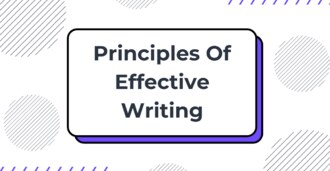


Write 10X Faster With AI-Powered Content
Create SEO-optimized articles in 15 minutes instead of 5 hours. Join 50,000+ content creators who generate content that ranks on top positions on Google. Save up to 80% of your time while getting 2X better results.
Try for Free →
